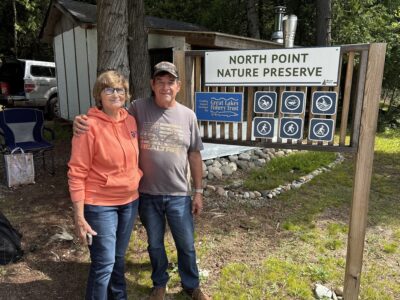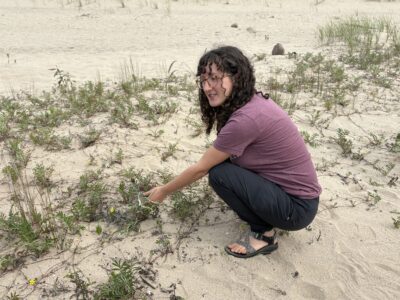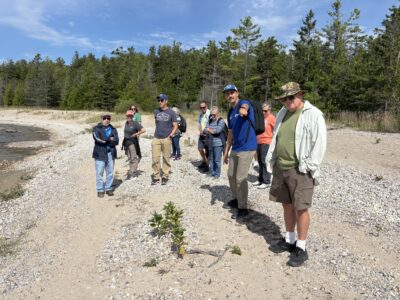Excursion at North Point Nature Preserve
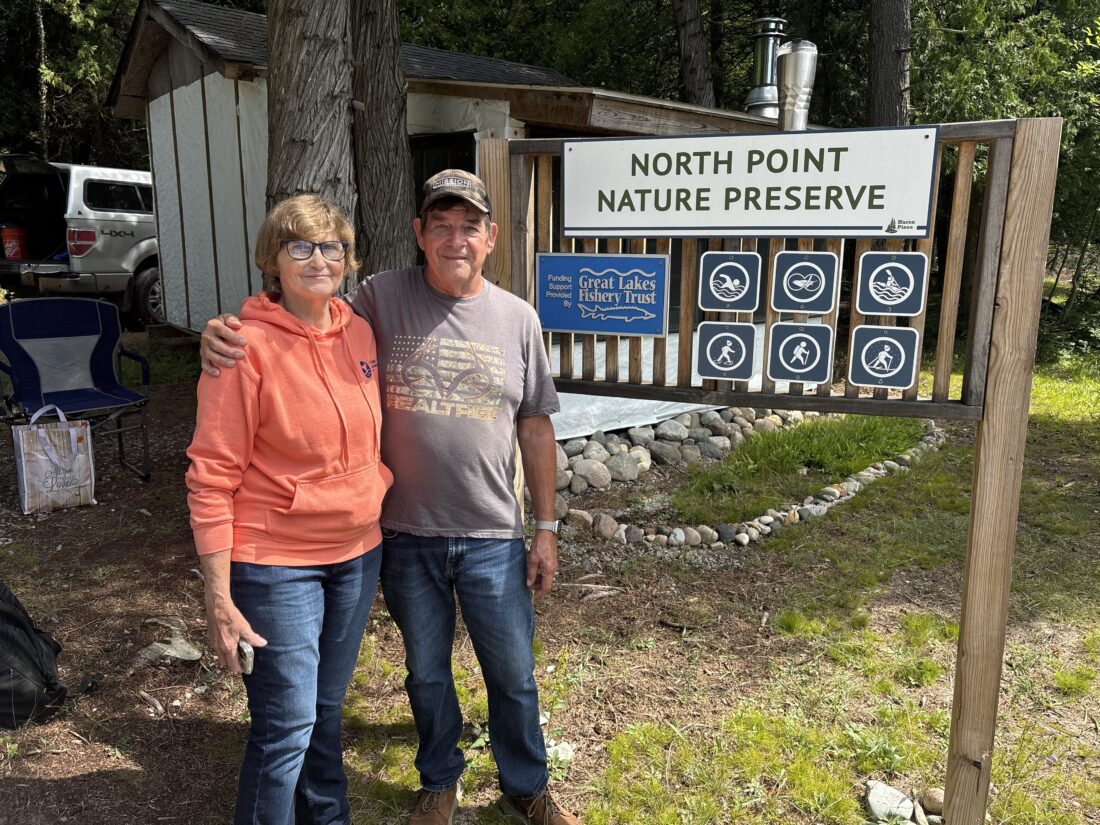
News Photo by Kayla Wikaryasz Linda Precord, left, and Dennis Precord, right, are seen standing in front of the North Point Nature Preserve sign. The Precords are caretakers of the preserve.
ALPENA — Huron Pines and the Thunder Bay National Marine Sanctuary (TBNMS) led a group of nature enthusiasts through North Point Nature Preserve, located at the north rim of Thunder Bay, on Friday.
Home to ecosystems only present in the Great Lakes, North Point Nature Preserve is also a time capsule that tells the story of the formation of the lakes and the maritime history of Alpena County.
Visitors to the preserve don’t have to walk far to find Petoskey stones, unique plant species, and even lumber washing to shore from the bygone logging days, old docks, or even shipwrecks.
According to Huron Pines Community Educator Madeline Khuri, The Nature Conservancy acquired the North Point Nature Preserve property in 2017. Collaborating with the Friends of Thunder Bay National Marine Sanctuary, The Nature Conservancy transferred ownership to Huron Pines for safekeeping in 2022.
Daniel Moffatt, TBNMS stewardship and education specialist, told participants that TBNMS decided that preservation and conservation of North Point Nature Preserve better aligned with Huron Pines’ mission since TBNMS focuses more on underwater conservation.
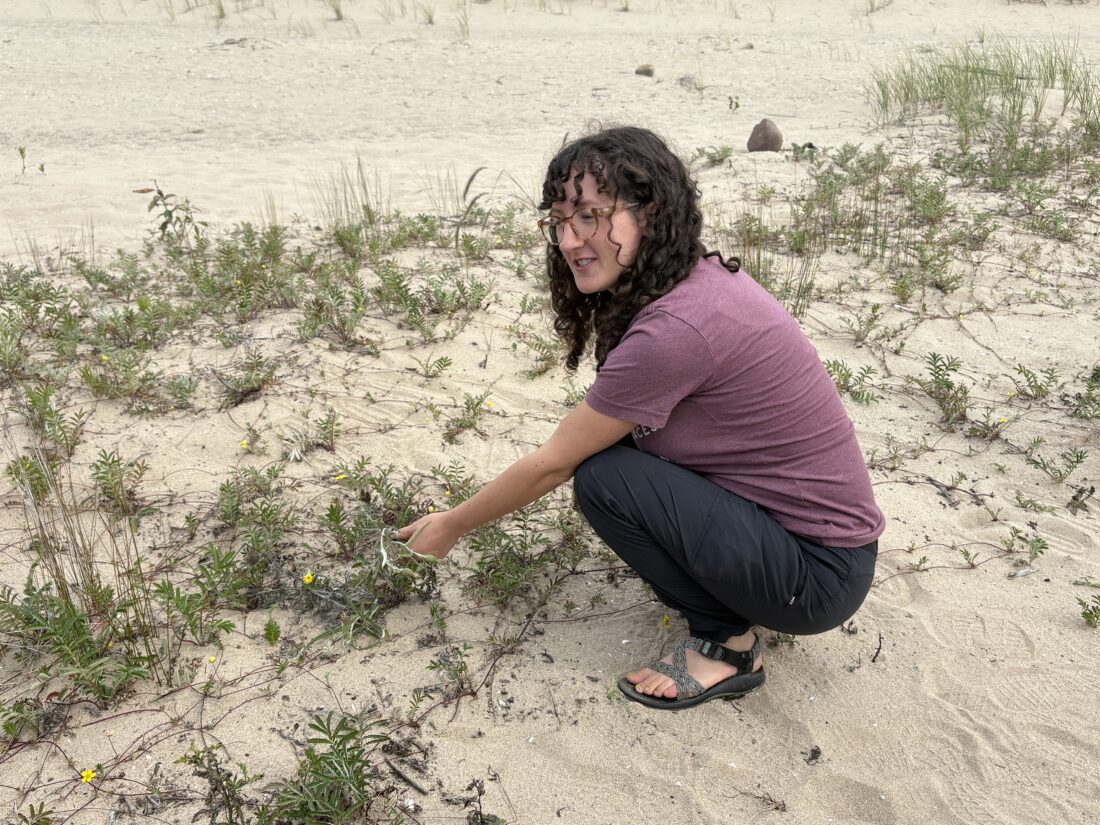
News Photo by Kayla Wikaryasz On Friday, Huron Pines Community Educator Madeline Khuri is seen showing a Pitcher’s thistle to nature enthusiasts at North Point Nature Preserve. Khuri said Pitcher’s thistle is unique to the Great Lakes region.
Moffatt explained that caretakers of the preserve, Linda and Dennis Precord, have a familial history tied to the land. He explained that Dennis Precord’s grandfather bought a 40-acre parcel of land from the State of Michigan in the 1930s.
“They have a really amazing history out here on the point,” Moffatt said. “They’re incredible people, and they are the caretakers of the preserve.”
Moffatt said Dennis Precord can often be seen on his tractor clearing trails at the preserve.
“They’re our boots on the ground,” Moffatt said. “We love having them as part of our team.”
Linda Precord said that through the different acquisitions of the property, her family wasn’t sure how much access they’d have to the preserve in the future. However, working in partnership with TBNMS and Huron Pines, they are looking forward to passing on the caretaker roles to their children and grandchildren.
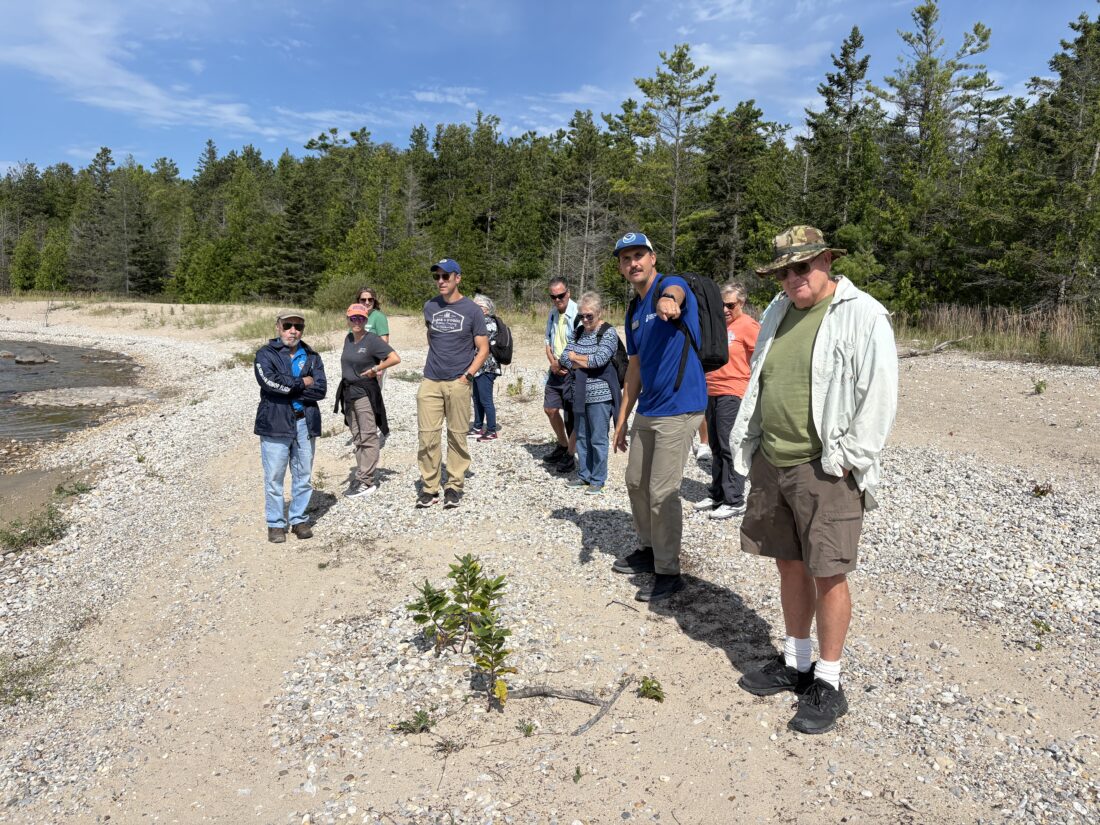
News Photo by Kayla Wikaryasz Daniel Moffatt, Thunder Bay National Marine Sanctuary stewardship and education specialist, is seen on Friday guiding nature enthusiasts along the shoreline at North Point Nature Preserve. Later, Moffatt led a hike that looped around the preserve.
On Friday, Moffatt and Khuri led participants around parts of the shoreline at the preserve and stopped to show participants a unique species of plant that is only native to the Great Lakes region.
Khuri told participants that Pitcher’s thistle grows in dune areas of the Great Lakes regions because they require the sand to propagate their seeds. She explained that the thistle takes seven to eight years to mature, blooms once, then dies.
“The seed falls onto the ground, and you’ll often see the babies coming up right around it,” Khuri said. “It needs the sand to scarify the seed to help it germinate, so that’s why it needs the healthy dune systems with a lot of movement to help the seeds germinate.”
Moffatt added that there seems to have been an increase in Pitcher’s thistle since TBNMS and Huron Pines acquired the preserve.
While leading participants down the shoreline, Moffatt pointed out shells of quagga mussels, which are an invasive species that have overrun zebra mussels.
“It’s kind of the cousin … bigger, faster, stronger cousin to the zebra mussel,” Moffatt said.
He said that zebra mussels have essentially been out-competed by the quagga mussels for food.
“Now … the food sources are completely depleted,” Moffatt said. “And so it totally changed the lakes … the ecology and the fishery.”
According to Moffatt, most mussels you find in the Great Lakes are quagga mussels competing for limited food sources.
Moffatt led participants on a longer hike through the preserve and noted best practices when engaging with nature preserve areas. He said if you find something that looks like a maritime artifact washed up on the beach from a shipwreck, the best practice is to leave it where it is and document its location and take a photo of the artifact.
“What they don’t want you to do is pick it up, put it in your pickup, and take it in and say, ‘Hey, I found this,'” Moffatt said.
Moffatt told participants that Huron Pines and TBNMS have consistently been reevaluating the extent to which they open the preserve up to the public. Currently, they give controlled excursions out to the preserve to mitigate negative impacts from public use.
However, he noted that if more people visit the preserve, there might be more reverence to the land and support to keep it in safe hands.
“The more you open it up to people, the more potential negative impact they can have,” Moffatt said. “But the more people see it, the more they value how incredible it is, and they want to protect it.”
Kayla Wikaryasz can be reached at 989-358-5688 or kwikaryasz@TheAlpenaNews.com.
- News Photo by Kayla Wikaryasz Linda Precord, left, and Dennis Precord, right, are seen standing in front of the North Point Nature Preserve sign. The Precords are caretakers of the preserve.
- News Photo by Kayla Wikaryasz On Friday, Huron Pines Community Educator Madeline Khuri is seen showing a Pitcher’s thistle to nature enthusiasts at North Point Nature Preserve. Khuri said Pitcher’s thistle is unique to the Great Lakes region.
- News Photo by Kayla Wikaryasz Daniel Moffatt, Thunder Bay National Marine Sanctuary stewardship and education specialist, is seen on Friday guiding nature enthusiasts along the shoreline at North Point Nature Preserve. Later, Moffatt led a hike that looped around the preserve.

